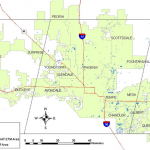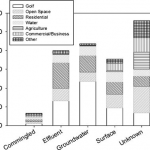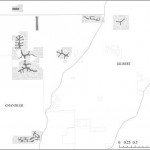Beginning with Hohokam irrigation canal construction over a thousand years ago, alterations to desert water systems have characterized the Phoenix area. Artificial lakes, constructed to connote a “desert oasis,” are among the most visible of these human created water features.
While investigating artificial lakes, former CAP Ph.D. student Libby Larson and CAP scientist Nancy Grimm found that existing maps of lakes in the metropolitan Phoenix area contained numerous inaccuracies. To create an accurate map, they used remote sensing imagery, GIS datasets, and state impoundment-permit information to identify lakes. Their work determined that there are between 900 and 1400 artificial lakes in the Phoenix metropolitan area, covering an area ranging from 7.9 to 8.2 km2, approximately 0.4% of the urbanized area (Figure 1).

The largest percentage of these lakes is associated with recreational uses, either golf courses or open space, followed by lakes located in residential developments (Figure 2). The sources of water for these lakes are groundwater, surface water, and effluent with a small number of lakes using comingled sources of water. Surprisingly, the water source for approximately 30% of the lakes is unknown according to the Arizona Department of Water Sources’ records. This situation has occurred because many of these lakes are too small to legally require permits. Other lakes on agricultural land also fall outside of reporting requirements.
Ecologically, lakes provide habitat as well as year-round water for numerous species, thus mitigating the seasonal variation in available surface water in the desert. Lakes that mimic natural systems, such as those in the Gilbert Riparian Preserve, have an important role in maintaining biodiversity in the city, and have become critical stopover locations for North American migratory birds. However, the attractiveness of lakes to waterfowl have led to problems as Canada geese and Mallard ducks have encroached on residential properties, golf courses, and pools. Larson and Grimm posit that lakes could help rid the city of excess nitrogen through a biogeochemical process that transforms the nitrogen to a harmless gas, such as in the chain of lakes composing Indian Bend Wash, which has been the subject of other investigations by CAP graduate student John Roach and others.

Lakes may also convey economic value to homeowners. CAP scientist Josh Abbott and colleague H. Allen Klaiber examined the effect that lakes had on housing values. Using the nearest neighbor matching method for comparing the prices of houses in communities (Homeowners’ Associations – HOAs) with and without lakes, they found that in many cases the presence of a lake in a community increased housing prices, particularly of properties directly adjacent to a lake (lakefront property). The average premium for lakefront properties across the lake communities in their sample was $31,271 compared to non-adjacent homes in the same community– an indication that people are willing to pay for direct access to lake amenities.
Maintaining water in artificial lakes is a particular issue in the urban desert where evaporation rates necessitate the replacement of six acre-feet/year for each acre of surface area, a cost which must be borne by the HOA. Larson and Grimm’s research found that the sources of water for lakes in the Valley of the Sun are roughly divided among groundwater, surface water, and treated effluent, all of which have differing prices. Abbott and Klaiber investigated whether the economic benefit of artificial lakes to homeowners outweigh the cost of water. They concluded that in most cases these benefits are substantially greater than the cost of water. They note that current water prices would need to change dramatically to remove incentives for future lake community development.

The premium value of lakefront properties is well-recognized and exploited by developers who design lakes to maximize frontage (Figure 3). These unnatural designs, which include many narrow inlets, may have ecological ramifications, such as low dissolved oxygen, algae accumulation, and poor water circulation, leading in some cases to fish death and a reduction in amenity value to homeowners. HOAs must bear the cost of dealing with these ecological problems. However, the economic benefits of lakes remain and because of this, homeowners are willing to pay over and above current HOA fees to maintain this artificial landscape feature.
The economics of artificial lakes in the Phoenix area indicate that these features will not be leaving the landscape any time soon and that new lakes may be incorporated into upcoming residential development. This may afford an opportunity for ecologists to work with developers to design lakes in a way that optimizes benefits for both homeowners and the environment.
References:
Abbott, J. K. and H. A. Klaiber. 2013. The value of water as an urban club good: A matching approach to HOA-provided lakes. Journal of Environmental Economics and Management. 65 (2): 208-224.
Larson, E. K. and N. B. Grimm. 2012. Small-scale and extensive hydrogeomorphic modification and water redistribution in a desert city and implications for regional nitrogen removal. Urban Ecosystems 15:71-85.
Roach, W. J., and N. B. Grimm. 2011. Denitrification mitigates N flux through the stream–floodplain complex of a desert city. Ecological Applications 21: 2618-2636.
Roach, W. J., J. B. Heffernan, N. B. Grimm, J. R. Arrowsmith, C. Eisinger and T. Rychener. 2008. Unintended consequences of urbanization for aquatic ecosystems: A case study from the Arizona desert. BioScience 58:715-727.


